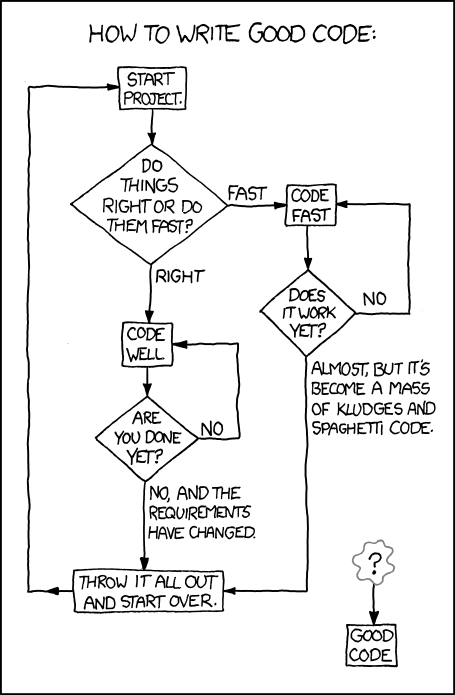It's funny 'cause it's true ...
From a little while ago, but I just flipped threw a few weeks worth of xkcd the other day and came across it.
When I was doing engineering at uni we talked about the reams of documentation and being able to pre-define the problem to such a degree that the coding itself would be an afterthought. A mere bullet-point to be performed by lowly trained knuckle dragging code monkeys somewhere between finalising the design and testing. Of course, this was proven to be immediately impractical during our final year project - and that was about the last time I ever saw an SDD. In one job I had we started with lofty goals of fully documenting it using references SRS and SDD's and the like but in the end we just ended up with piles of junk. They were complete, and even sometimes up to date but ultimately useless - they didn't add any value.
In reality of course there are many impediments to such an approach:
- The customer doesn't know what they ultimately want. Ever.
- New ideas come along which change or add requirements.
- You don't know the best way to solve a problem without trying it.
- You don't know where to even start solving problems without plenty of experience.
- The market or other outside circumstances force a change.
- That just isn't how the brain works - you continue to learn every second of every day and that changes how you would solve problems or present them.
- It's slow and too expensive for anyone who has to earn money and not just ask for it (i.e. outside of defence, govt).
Although contracts are still written this way, and documentation is still a phone-book sized deliverable in military software. And computer engineering academia are still trying to turn what is essentially an art, into a science. I don't think their efforts are completely worthless (at least not all of them), but I think software is too complex for this at this stage and only getting more complex.
It's not that development documentation isn't useful - I wouldn't mind a good SRS myself - but there needs to be a happy medium.
Back to the flow-chart - which to me has a deeper meta-meaning even by being a flow-chart. The software engineering lecturers scoffed at flow-charts as being obsolete and out of date - yet they seem to be more useful than anything they claimed replaced it.
Personally I try to do it right but sometimes do it fast - because ultimately you always end up having to refresh a significant chunk of the code-base when the customer reveals what they really wanted from the start. Fortunately when i'm in the groove (say 30% of the time?) I can hack so fast and well (not to put tickets on myself, but i can) the line is a bit blurred - writing and (re)-re-factoring gobs of code on the fly as the design almost anneals itself into a workable solution. Pity I can't do that all the time.
Extra effort is usually is worth it, but not always. And sometimes the knack is just knowing when you get get away with taking short-cuts. For isolated code at the tail-end of the call-graph it usually makes little difference so long as it works.
If you throw the front-end away and start from scratch and you have some well designed code underneath, you can usually re-use most of it. Crappy code is much harder to re-use. But in the earlier stages of a project doing it right can be more of a hindrance. Particularly with OO languages - which force you to create good data models to fit the problem - which means even a small change to the problem can be a big change to the data model. Of course, many coders never achieve good data models, so perhaps for them the cost isn't so high - at the cost of perpetually low quality code. Yes I say data, not code - the data is always more important.
Annealing is probably a good way to describe software design and maturity process - early stages punctuated by large fluid changes due to high-energy experimentation then and over time the changes becoming smaller as it matures and solidifies. If the requirements change you have to put it back into the fire to liquefy the structure and reconsider how it fits in the new solution.
Simply bolting on new bits will only create an ugly and brittle solution.

